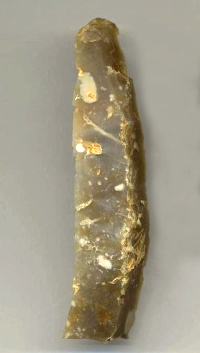
|
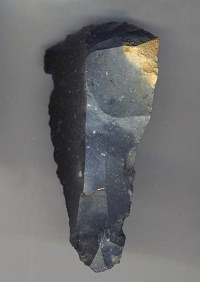
|
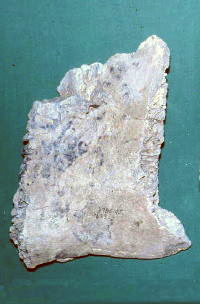
|
Stratum 3: Yellowish Clay
Stratum 3 is the lowest layer with definitive evidence of human occupation at Horn Shelter. Distinctive tool forms, including a blade, along with a radiocarbon date of nearly 12,000 calendar years before present, indicate this was a Clovis occupation. Of particular interest were the remains of large turtle left by the campers.
Three small hearths, chert flakes, an end scraper, ocher fragments, and a blade made of Edwards chert were found, along with a small number of animal bones. The blade has typical Clovis attributes. In Clovis Blade Technology (1999; University of Texas Press), archeologist Michael Collins describes the Horn Shelter specimen as triangular in cross section, with a smooth interior, small bulb, and small platform. The distal portion of the blade is missing, he notes, due to a break caused by a flaw in the chert. Width of the blade is 19 mm and thickness 7.3 mm. When complete, the blade would have measured more than 75 mm in length.
The end scraper also is made on a blade of dark-colored, opaque chert. The distal end has been shaped into a beveled tool edge, and a single notch has been chipped on one edge, possibly to enable hafting. Similarly notched blade tools were recovered at the Pavo Real site in south Texas (41BX52).
The small fire hearths were represented by dark-stained soil and charcoal fragments. As with other hearths of Paleoindian age, the fires apparently had been built directly on the ground, without rocks.
The carapace, or exo-skeleton, segments of a very large land turtle also were found in an apparent deliberately arranged cluster. The remains were identified as Geochelone sp. (now extinct) or Gopherus sp. (some species of which are extinct), by Ernest Lundelius of the University of Texas at Austin, Vertebrate Paleontology Laboratory. The radiocarbon date of 10,150 +/- 120 BP (11,778+/-275 Cal. RCYBP.) was obtained from turtle shell apatite. Because the sample is bone, this estimate likely is somewhat younger than true age.
Other animal remains found in this stratum are cattfish and freshwater drum, rodents, and other small mammals. A variety of land snails also were recovered, including Anguispira strongylodes (Southeastern Tigersnail) and Mesodon sp., both of which favor riparian woodlands, such as that still present today along the Brazos River.
Evidence of Geochelone predation by early peoples has been found at the Little Salt Spring sinkhole site in southwest Florida. The collapsed shell of one of these extinct land tortoises was found with an apparent wooden stake driven between the shell (carapace) and rib portions (plastron). Based on fire-hardened clay under the shell, the animal had been cooked in upside down position. Wood was carbon dated to 12,030 years ago.
Description of Deposit: Chiefly a yellowish clay that has been mixed lightly with red sand, small limestone fragments, and caliche nodules. It is tough and waxy when wet. Only limited evidence of cultural occupation was present. Radiocarbon Date: 10,150 +/- 120 BP; (11,778+/-275 CRCYBP) on bone apatite Cultural Affiliation: Early Paleoindian, Clovis |
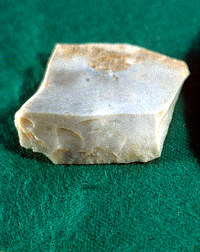
|
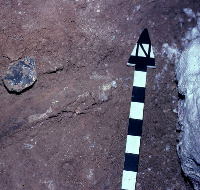
Utilized flake of dark chert, left, found in association with turtle bones, several of which have been jacketed in plaster (right). Photo by Albert Redder. |
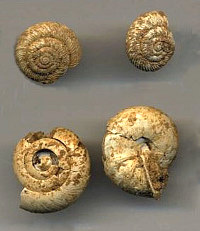
|